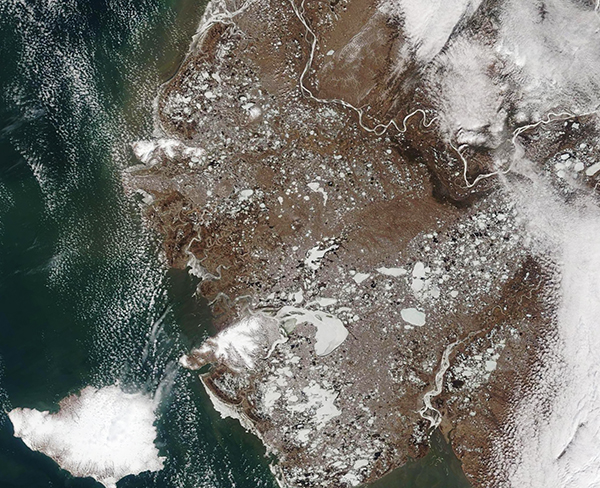Images
May 5, 2022 - Yukon Delta Wildlife Refuge
Tweet
Despite springtime’s lengthening daylight, most of Alaska’s Yukon Delta National Wildlife Refuge retains a late-winter appearance as the major rivers, lakes and wetlands remain coated with ice in early May 2022. The Moderate Resolution Imaging Spectroradiometer (MODIS) on board NASA's Terra satellite acquired a true-color image of an icy spring day on the refuge on May 3.
Nighttime low temperatures have been staying below freezing in late April and early May this year, but with daylight temperatures consistently rising about 10˚F above freezing across most of the refuge, ice breakup across the refuge will soon begin. In most years, ice breakup begins in late April or May and is completed by late May.
The Yukon River originates in British Columbia, Canada, and flows through Yukon Territory before entering the U.S. state of Alaska. As the Yukon River nears the Bering Sea, it spreads out in braided meanders, creating a vast delta in the low-lying coastal tundra plain. In the south, the meanders of the Kuskokwim River add to the wetlands of the Yukon Delta. The meanders of the two major rivers feed a multitude of channels, coastal ponds, lakes, and wetland, creating a unique environment that is important and vital habitat for waterfowl, migratory, and breeding birds as well as provides critical spawning habitat for Pacific salmon species. The coastal waters are home to a variety of marine mammals, including whales that swim through the Bering Sea during migration. In the drier uplands, animals such as bear, caribou, moose, wolves and muskox thrive.
The Yukon Delta National Wildlife Refuge spans 19.16 million acres (77,500 square km), making it the second-largest National Wildlife Refuge in the United States (the Arctic National Wildlife Refuge is the largest). The importance of preserving this delta and adjacent lands of southwestern Alaska was first officially recognized when President Theodore Roosevelt first created refuge lands in the area in 1909. In 1980, President Jimmy Carter signed the Alaska National Interest Lands Conservation Act into law, which consolidated existing refuges, added more protected lands, and created the Yukon Delta National Wildlife Reserve.
Not only is the Yukon Delta an important home for wildlife, it is one of the most populated rural areas in Alaska, with over 50 Indigenous communities. As the ancestral home of the Yup’ik, Cup’ik, and Deg Xit'an people of Alaska, this is a region rich in culture, where residents depend on the wildland, waters, and wildlife to support an active subsistence way of life. Unlike many wildlife refuges, which focus solely on the wildlife and habitat within their boundaries, goals of the Yukon Delta Wildlife Refuge focus not only on conserving fish and wildlife populations and their habitats in their natural diversity, but also to provide the opportunity for continued subsistence uses by local residents.
Image Facts
Satellite:
Terra
Date Acquired: 5/3/2022
Resolutions:
1km (191.6 KB), 500m (591.9 KB), 250m (1.6 MB)
Bands Used: 1,4,3
Image Credit:
MODIS Land Rapid Response Team, NASA GSFC
Tweet
Despite springtime’s lengthening daylight, most of Alaska’s Yukon Delta National Wildlife Refuge retains a late-winter appearance as the major rivers, lakes and wetlands remain coated with ice in early May 2022. The Moderate Resolution Imaging Spectroradiometer (MODIS) on board NASA's Terra satellite acquired a true-color image of an icy spring day on the refuge on May 3.
Nighttime low temperatures have been staying below freezing in late April and early May this year, but with daylight temperatures consistently rising about 10˚F above freezing across most of the refuge, ice breakup across the refuge will soon begin. In most years, ice breakup begins in late April or May and is completed by late May.
The Yukon River originates in British Columbia, Canada, and flows through Yukon Territory before entering the U.S. state of Alaska. As the Yukon River nears the Bering Sea, it spreads out in braided meanders, creating a vast delta in the low-lying coastal tundra plain. In the south, the meanders of the Kuskokwim River add to the wetlands of the Yukon Delta. The meanders of the two major rivers feed a multitude of channels, coastal ponds, lakes, and wetland, creating a unique environment that is important and vital habitat for waterfowl, migratory, and breeding birds as well as provides critical spawning habitat for Pacific salmon species. The coastal waters are home to a variety of marine mammals, including whales that swim through the Bering Sea during migration. In the drier uplands, animals such as bear, caribou, moose, wolves and muskox thrive.
The Yukon Delta National Wildlife Refuge spans 19.16 million acres (77,500 square km), making it the second-largest National Wildlife Refuge in the United States (the Arctic National Wildlife Refuge is the largest). The importance of preserving this delta and adjacent lands of southwestern Alaska was first officially recognized when President Theodore Roosevelt first created refuge lands in the area in 1909. In 1980, President Jimmy Carter signed the Alaska National Interest Lands Conservation Act into law, which consolidated existing refuges, added more protected lands, and created the Yukon Delta National Wildlife Reserve.
Not only is the Yukon Delta an important home for wildlife, it is one of the most populated rural areas in Alaska, with over 50 Indigenous communities. As the ancestral home of the Yup’ik, Cup’ik, and Deg Xit'an people of Alaska, this is a region rich in culture, where residents depend on the wildland, waters, and wildlife to support an active subsistence way of life. Unlike many wildlife refuges, which focus solely on the wildlife and habitat within their boundaries, goals of the Yukon Delta Wildlife Refuge focus not only on conserving fish and wildlife populations and their habitats in their natural diversity, but also to provide the opportunity for continued subsistence uses by local residents.
Image Facts
Satellite:
Terra
Date Acquired: 5/3/2022
Resolutions:
1km (191.6 KB), 500m (591.9 KB), 250m (1.6 MB)
Bands Used: 1,4,3
Image Credit:
MODIS Land Rapid Response Team, NASA GSFC




